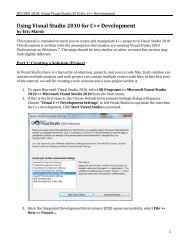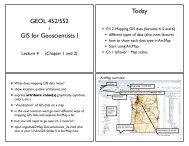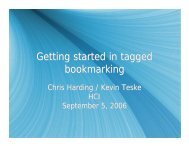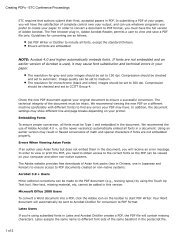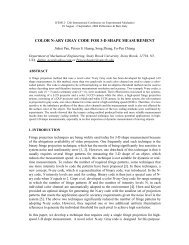Harnessing the Crowdsourcing Power of Social Media for Disaster ...
Harnessing the Crowdsourcing Power of Social Media for Disaster ...
Harnessing the Crowdsourcing Power of Social Media for Disaster ...
- No tags were found...
Create successful ePaper yourself
Turn your PDF publications into a flip-book with our unique Google optimized e-Paper software.
Figure 2. Food requests after <strong>the</strong> Haiti earthquake. The Ushahisi-Haiti crisis map helps organizations intuitively ascertain wheresupplies are most needed.geo-location point. Someone mighttext <strong>the</strong> crisis map’s phone numberto report something <strong>the</strong>y saw earlier,possibly texting from a shelter abouta bridge that collapsed 10 miles down<strong>the</strong> road. Fur<strong>the</strong>rmore, fraud reportsfrom malicious persons might appearas normal requests on crisis map. Inaddition, <strong>the</strong>re are <strong>of</strong>ten duplicatereports, and in<strong>for</strong>mation essential<strong>for</strong> relief coordination is not readilyavailable or easily accessible, such aslists <strong>of</strong> relief resources or communicationprocedures and relief organizationcontact in<strong>for</strong>mation.Lastly, current crowdsourcing applicationsdo not have adequate securityfeatures <strong>for</strong> relief organizationsand relief operations. For example,crowdsourcing applications that arepublicly available <strong>for</strong> reporting arealso publicly available <strong>for</strong> viewing.Although it is important to providein<strong>for</strong>mation to <strong>the</strong> public, this cancreate conflicts when decisions mustbe made about where and when reliefresources are needed. In somecircumstances, relief workers <strong>the</strong>mselvesmight be targeted by nefariousgroups, so publicizing details aboutrelief ef<strong>for</strong>ts could endanger <strong>the</strong>m.Challenges and ResearchIssues<strong>Social</strong> media as a crowdsourcingmechanism provides aggregate situationalawareness, important andnew communications pathways, andsome opportunities <strong>for</strong> assistance onan individual level. However, to makecrowdsourcing a useful tool, we mustaddress several challenges to leverageboth <strong>the</strong> data and communicationscapabilities, including sensemaking,security, and coordination. To tackle<strong>the</strong>se problems, we can employ textmining and social computing technologiesby managing social knowledgeand modeling social behavior during<strong>the</strong> disaster relief. 11Geo-tag DeterminationAs we mentioned earlier, crowdsourceddata might include inaccurategeo-tags, or might not include<strong>the</strong>m at all. Thus, using social miningto consider both a reporter’s socialand physical networks couldhelp locate a report’s actual spatialfeatures.In addition, research has shown <strong>the</strong>need to leverage <strong>the</strong> in<strong>for</strong>mation availablefrom <strong>the</strong> response group. For example,to supplement crowdsourcingin<strong>for</strong>mation, groupsourcing 10 collectsdisaster in<strong>for</strong>mation such as a reliefsituation summary, validated geotagin<strong>for</strong>mation, and transportationconditions provided by a sanctionedgroup consisting <strong>of</strong> individuals withdisparate resources, goals, and capabilitiesworking at <strong>the</strong> disaster scene.Report VerificationTo some degree, crowdsourcing canautomatically filter reports throughphotos, videos, and comments fromo<strong>the</strong>r reports. Ushahidi, <strong>for</strong> example,lets users verify a report by clickinga verification button. It leaves <strong>the</strong>verification problem to <strong>the</strong> crowdsto get collective feedback. However,this strategy—an open self-adjustingmethod, in technical terms—dependson a large number <strong>of</strong> people validating<strong>the</strong> reports. For Ushahidi maps,however, generally only a few people12 www.computer.org/intelligent Ieee INTELLIGenT SYSTemS
Figure 3. Ushahidi’s Japanese tsunami map. By visualizing <strong>the</strong> most affected locations, <strong>the</strong> map helps relief organizationscoordinate and prioritize <strong>the</strong>ir responses.serve as verifiers, across <strong>the</strong> spectrum<strong>of</strong> Ushahidi map cases. A fraudulentmessage could conceivably propagateitself quickly with good camouflage,especially in a chaotic disaster environment,unless better incentives <strong>for</strong>verification are present.As crisis maps and similar crowdsourcingapplications are developed,it will be necessary to develop trustmanagement systems that can recognizeand report questionable postingsand flag <strong>the</strong>m <strong>for</strong> more scrutiny andverification.Automated Report SummarizationPolice departments and o<strong>the</strong>r first responderswill need summarized requestreports and <strong>the</strong> ability to drilldown to individual tweets and texts.Because <strong>the</strong> volume and tempo <strong>of</strong>messages in a massive disaster will beso high, automated summaries andanalysis to make sense <strong>of</strong> hundreds, ifnot thousands, <strong>of</strong> unstructured messageswill be ano<strong>the</strong>r greatly neededcapability.Spatial-Temporal Mining <strong>for</strong> <strong>Social</strong>Behavior PredictionCurrently, volunteers and victimson <strong>the</strong> ground report incidents andrequests—that is, people who have aphone or o<strong>the</strong>r communication device.There are no applications <strong>for</strong><strong>for</strong>ecasting future requests or <strong>for</strong> fillingin <strong>the</strong> likely requests that wouldcome from blacked-out areas if suchpeople experience limited communicationability.Scientific data on earthquakes,floods, and o<strong>the</strong>r phenomena couldaugment user data to populate modelsto predict <strong>the</strong> time and location<strong>of</strong> future requests and needs. Crowdsourceddata plus model results couldhelp first responders, governmentalagencies, and NGOs get ahead <strong>of</strong> <strong>the</strong>demand curve and become more proactivein deploying aid and rescue capabilities.One possibility is to designspatiotemporal classifiers <strong>for</strong> modelsthat will assist in such demand<strong>for</strong>ecasts.Scalability and SafetyScalability is a problem <strong>for</strong> many intelligentdistributed systems because <strong>the</strong>increasing number <strong>of</strong> requests, agencies,and agent behaviors significantlymay/june 2011 www.computer.org/intelligent 13
enlarges <strong>the</strong> dimension <strong>of</strong> <strong>the</strong> searchspace. 3 Large-scale data-managementtechnology will be necessary to maintaina system’s stability.Safety is ano<strong>the</strong>r problem thatmust be considered in a disaster reliefmanagement plan, especially in <strong>the</strong>design <strong>of</strong> a crowdsourcing system.While making data publically available,such systems must protect <strong>the</strong>NGOs’ privacy and ensure <strong>the</strong> safety<strong>of</strong> <strong>the</strong>ir workers.<strong>Crowdsourcing</strong> integrated with crisismaps has been a powerful tool inhumanitarian assistance and disasterrelief. Future crowdsourcing applicationsmust provide capabilities to bettermanage unstructured messagesand enhance streaming data. Enhancementswill also include methods<strong>of</strong> fusing in<strong>for</strong>mation with data fromo<strong>the</strong>r sources, such as geological dataabout fault lines and reports <strong>of</strong> variousearthquake aftershocks. Researchersare just beginning to consider trustmanagement systems to help evaluatemessages with respect to <strong>the</strong> hugetroves <strong>of</strong> messages being traded incyberspace and via cell phones.Fur<strong>the</strong>rmore, metrics that gauge <strong>the</strong>success <strong>of</strong> crowdsourcing and coordinationsystems <strong>for</strong> disaster relief willbe designed and leveraged <strong>for</strong> systemevaluation and improvement. Creatingan automatic recommendation systemthat helps improve resource distributioncoordination and transportationroutesuggestions is ano<strong>the</strong>r researchdirection that can utilize real-timedata collection and relief history.There is no doubt that new coordinationplat<strong>for</strong>m and crowdsourcingapplications such as crowdsourcedtranslation, filtering, and categorizationwill continue to become availableand will significantly contributeto future disaster relief ef<strong>for</strong>ts. Weare confident that great numbers<strong>of</strong> lives will be saved as governmentsand NGOs find better ways toemploy <strong>the</strong> integration <strong>of</strong> socialmedia, crowdsourcing, and collaborativetools into disaster relief systems.References1. J. Morgan, “Twitter and FacebookUsers Respond to Haiti Crisis,” BBCNews, 15 Jan. 2010; http://news.bbc.co.uk/2/hi/americas/8460791.stm.2. Digital Blogger, “Japan Tsunamiand Earthquake Use <strong>of</strong> Twitter,Facebook, Skype and O<strong>the</strong>r <strong>Social</strong>Networks,” 12 Mar. 2011; http://bubblecube.wordpress.com/2011/03/12/japan-tsunami-earthquake.3. A. Bedrouni et al., Distributed IntelligentSystems: A Coordination Perspective,Springer, 2009.4. R. Goolsby, “<strong>Social</strong> <strong>Media</strong> as CrisisPlat<strong>for</strong>m: The Future <strong>of</strong> CommunityMaps/Crisis Maps,” ACM Trans. IntelligentSystems Technology, vol. 1, no.1, 2010, article no. 7.5. J. Howe, “The Rise <strong>of</strong> <strong>Crowdsourcing</strong>,”Wired, vol. 14, no. 6, 2006, pp. 1–4.6. J. Surowiecki, “The Wisdom <strong>of</strong>Crowds,” Am. J. Physics, vol. 75, no. 2,2007, p. 190.7. P. Meier and K. Brodock, “CrisisMapping Kenya’s Election Violence,”iRevolution blog, 23 Oct. 2008; http://irevolution.net/2008/10/23/mappingkenyas-election-violence.8. J. Heinzelman and C. Waters,<strong>Crowdsourcing</strong> Crisis In<strong>for</strong>mation in<strong>Disaster</strong>-Affected Haiti, US Inst. <strong>of</strong>Peace, 2010.9. CrowdFlower, “Mission 4636,” 2010;www.mission4636.org.10. H. Gao et al., “Promoting Coordination<strong>for</strong> <strong>Disaster</strong> Relief: From<strong>Crowdsourcing</strong> to Coordination,”Proc. Int’l Conf. <strong>Social</strong> Computing,Behavioral-Cultural Modeling, andPrediction, Springer-Verlag, 2011,pp. 197–204.11. F.-Y. Wang et al., “<strong>Social</strong> Computing:From <strong>Social</strong> In<strong>for</strong>matics to <strong>Social</strong> Intelligence,”IEEE Intelligent Systems,vol. 22, no. 2, 2007, pp. 79–83.Our experts.Your future.Huiji Gao is a PhD student in <strong>the</strong> DataMining and Machine Learning (DMML)lab at Arizona State University. Contact himat Huiji.Gao@asu.edu.Ge<strong>of</strong>frey Barbier is a doctoral candidatein computer science and a student in<strong>the</strong> Data Mining and Machine Learning(DMML) lab at Arizona State University.Contact him at gbarbier@asu.edu.www.computer.org/bycRebecca Goolsby is an anthropologist <strong>for</strong><strong>the</strong> US Office <strong>of</strong> Naval Research. Contac<strong>the</strong>r at rebecca.goolsby@navy.mil.14 www.computer.org/intelligent Ieee INTELLIGenT SYSTemS





